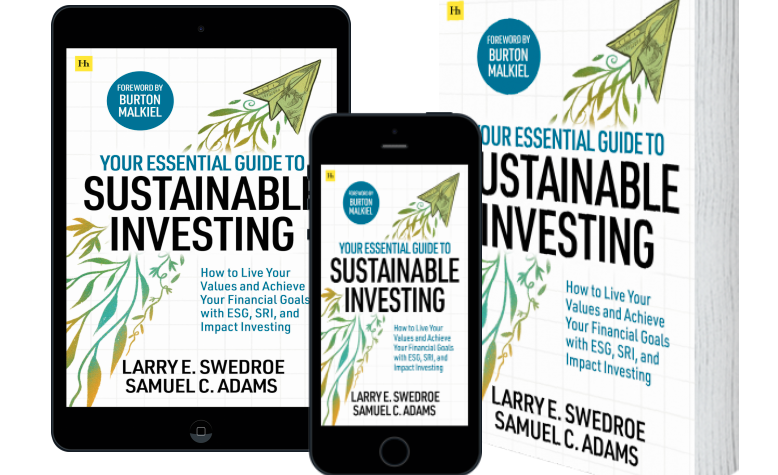Monthly Book Review: Your Essential Guide to Sustainable Investing

There are many ways to name the phenomenon that is sustainable investing – green investing, ethical investing, impact investing and so on. However you describe it there’s no doubt that the industry is huge and continuing to boom. According to recent figures from the Global Sustainable Investment Alliance, assets under management around the world that could be classed as sustainable surged from $30.7 trillion in 2018 to $35.3 trillion in 2020. That’s about the same as the annual GDP of the United States, Japan and Germany combined and an estimated 36% of all professionally managed financial assets.
Reading the news every day and there are more and more examples of financial institutions making sustainable investing a key part of their strategies. Perhaps the biggest recent headline in the industry was at last year’s high profile COP26 conference in Glasgow. Here it was announced that the Glasgow Financial Alliance for Net Zero, a global coalition of leading financial institutions looking to accelerate the transition to a net-zero global economy, had attracted members with total assets of $130 trillion. Elsewhere, Scottish Widows recently announced an expansion of its negative screening approach, saying it will no longer invest in tobacco stocks and limit investments in coal. The pensions provider has now divested £3 billion from investments it considers to be unethical.
For those interested in getting more involved in sustainable investing this new book from authors Larry Swedroe and Sam Adams is one of the most thorough guides on the market right now. Through eight chapters, Your Essential Guide to Sustainable Investing provides readers with a comprehensive review of what exactly the industry is and a practical guide to making money in a sustainable manner. The authors are experienced industry veterans, with Adams being CEO and co-founder of dedicated ESG investment firm Vert Asset Management and Swedroe being chief research officer at Buckingham Strategic Wealth.
Sustaining wealth and happiness
The first few chapters of the book kick off by answering the what, how and who questions about sustainable investing. The authors categorise sustainable investing into three general categories, Environmental, Social and Governance (ESG), Socially Responsible Investments (SRI) and impact investments. All of these fall on a spectrum between maximising financial returns and maximising social and environmental goals. ESG strategies for example aim to maximise financial returns for the risk taken – they put financial returns first while also considering ethical factors. Impact investing meanwhile primarily focusses on social outcomes, with financial returns being secondary.
According to Chapter 3, practically every section of the investment community is getting involved in sustainable investing, from sovereign wealth funds and pension plans to individual investors and family offices. And why are they doing it? Put simply, they want their money to be a factor for good. Chapter 4 goes into further details on the motivations of sustainability investors, with the point being that not all returns are financial. It can be incredibly rewarding for investors to see that their money is doing good in the world. From building homes for disadvantaged communities, protecting the environment, or even something as simple as creating a pleasant environment for employees, the returns here are potentially unlimited.
Of course, with money involved, sustainable investors are also looking for financial returns. But do sustainable investments do as well as the rest of the market? This subject is covered in great detail in Chapter 6, with the authors examining a range of academic research published over the past few decades. The conclusion here is that the evidence is mixed on the hypothesis that sustainable investments provide higher returns or lower risks. Looking at the data, it’s easy to find examples of sustainable funds that have underperformed and also evidence that so called “sin stocks” (like tobacco, oil and alcohol) have outperformed. Also worth noting is that one 2019 study by Bansal et al concluded that green stocks outperform “brown” stocks in good times but underperform in bad times. This is partly due to the fact that green stocks are in higher demand when the economy does well, a time when financial concerns matter less.
Finally, Chapter 8 offers practical advice on how exactly the typical retail punter can get involved in the markets and create a portfolio of sustainable investments. The point is made that the fundamental principals of investing remain the same in this industry, with the concepts of diversification, asset allocation, investing for the long-term and fundamental analysis being critical. The authors offer a range of advice covering when to use a professional advisor and how to research potential investment managers.
Also discussed is the concept of “greenwashing”, the process whereby a company conveys a false impression about the environmental soundness of its business. Just because an oil company puts pictures of trees and rabbits on its website doesn’t mean that it operates in an environmentally sustainable manner. Providing some credible investment options, one of the five appendices to the book contains a list of appropriate mutual funds and ETFs that investors might want to consider.
Money and Morals
For those investors who enjoy the warm feeling of doing good, sustainable investing is attractive. If you can make money while also helping people and the planet, what’s not to like. Of course, like all investments, their future financial performance is not guaranteed. But there is much more at stake here. The world is changing, and the unacceptable face of capitalism no longer has a place in it. For those who want to learn how to match their morals with their money, Your Essential Guide to Sustainable Investing is indispensable reading.
Comments (0)